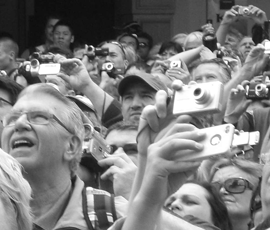The project aims to revolutionise the way people’s digital content is managed and used and, using a combination of mathematics and ICT, transform it into broadcast-quality footage.
Professor Andrea Cavallaro from Queen Mary’s School of Electronic Engineering and Computer Science is leading ‘Multisource audio-visual production from user-generated content’ with funding from the Engineering and Physical Sciences Research Council (EPSRC).
He said: “The large amount of data increasingly available and their varying quality makes the selection and editing of appropriate multimedia items quickly very difficult.
“This limits the opportunity to gather this data for security, cultural and entertainment applications. We will devise new ways to handle content from multiple sources to improve audiovisual production and to enable synchronisation and processing. This will, in turn, allow generation of novel and higher quality audio-visual rendering of captured events.”
The research’s focus is on being able to use artificial intelligence and complex mathematical calculations to combine crowd-generated footage of an event and generate professional standard reportage from it. These algorithms will used to identify edits and links between events, such as timings and viewpoints. This will also be relevant to security, as a means of wading through a vast quantity of CCTV footage.
This research will go beyond the work that is currently taking place elsewhere that allows people to stitch together footage at for example, a concert or school play, where the music can be used as a handy click-track to synchronise the video.
David Delpy, Chief Executive of EPSRC said: “This research is an exciting use of maths and ICT through our Digital Economy theme and will undoubtedly have implications for both how information is exchanged and news is reported.
“It will be revolutionary in opening up who contributes content to news broadcasts and support the development of video-based citizen journalism. It is also a good example of how developments in the sciences and engineering have a wider societal impact.”



